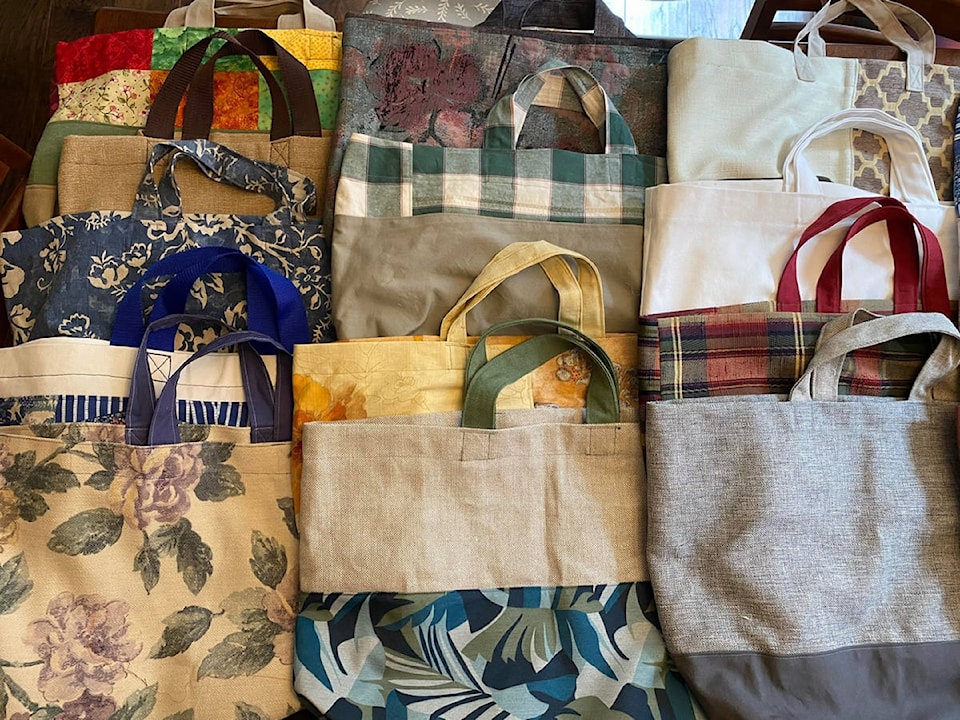The Inuvik Food Bank is getting a little bit greener thanks to group of volunteer sewing enthusiasts in Burnaby, B.C.
Food bank president Angela McInnes said she first heard about the program after discovering it over Facebook.
“I saw a post about a group giving out handmade reusable bags to food banks and schools. It had a post inviting people to request a free pattern,” she said. “I wanted a natural material if possible. Something machine washable.
“It was on a whim when I sent in a request for a pattern. I discovered a pattern for me is like a foreign language. I am more visual and tactile. I can copy what I can feel with my hands so the patterns sat unused.”
Having already removed single-use plastic bags from their operations in 2019, the Inuvik Food Bank has been using reusable bags acquired from other businesses around Inuvik.
However, many of those bags, made of recycled plastic, were showing up in the landfill, completely defeating the purpose. On top of that, the initial supply of re-usable bags from Arctic Energy Alliance was beginning to dwindle and she was unable to determine where they purchased them. So she reached out to the Fabric Bag Solution Volunteer Sewing Group to arrange a sewing party to stock the bank with its own supply of environmentally friendly distribution.
The plan was to sew the bags in Inuvik as part of a community-wide project.
…and then Covid-19 hit. With her other commitments to Arctic Paws, Uggies and Grins and other community groups, the project fell by the wayside until Fabric Bag Solution founder Joanne Morneau reached out to McInnes several months later.
The two brainstormed the “big bag” — a large re-usable tote bag to efficiently carry groceries. Cushioning salvaged from old mattresses was donated by another group, Canadian Mattress Recycling, and a dedicated group of sewers from around the B.C. coast and interior got to work making the new bag.
“I am so happy to be working with the Inuvik Food bank. All the pieces just fell into place,” said Morneau. “For years, I have been saddened to see our whales and sea life drowning with bellies full of our plastics.
“Many of us feel discouraged and angry that the polar caps are melting and the sea water is rising. Being able help Angela and her community, who are so vulnerable to climate change, gives me hope for the future.”
McInnes said the bags were already on their way in two shipments. She anticipates she will have 90 bags to distribute at first and 150 by the time the shipment is complete.
Her next task, she noted, was determining a way to ensure the handcrafted bags are reused and don’t get thrown out.
“I think we will have the bags be emptied at the door when delivered so the delivery person can bring back to the the food bank,” she said. “Then we wash and reuse.
“It will save thousands of the bags we use per year if it works.”
Clothing, fabric and other textiles are one of largest sources of global pollution. It is estimated that only 20 per cent of textiles are recycled, the other 80 per cent either end up in a landfill, are incinerated into greenhouse gases, or end up in the ocean.
Morneau noted she initially founded Fabric Bag Solution after seeing plastic bags strangling fish during a caribbean vacation.
“Our big bags for the Inuvik Food Bank are mini works of art,” said volunteer sewer Julie Silgailis. “People actually prefer our fabric tote bags over the over mass produced plastic and polypropylene bags, often covered in advertising and corporate logos that often rip, cut into your hand, leak and then end up in the landfill for hundreds of years.”
